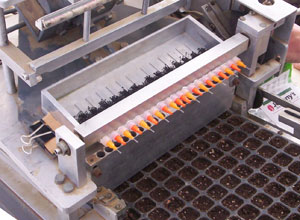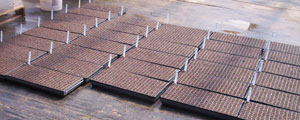

Mondays at the Farm
Mon 2010-03-15 13:19:51 (in context)
A friend of mine wanted to know what it is precisely that I do at Abbondanza. The quick answer is, "Not nearly enough," and probably would be even if I volunteered there every day instead of one morning a week and didn't feel guilty giving the farmers an extra job to do, namely, assigning me tasks and making sure I don't screw them up along with the farm's chances at a successful harvest. But it's not a useful answer. Therefore, I blog.
Writing five days a week gives me a two-day weekend, which I take on Sunday and Monday. Sunday because social stuff tends to get planned then. Mondays because of the farm. I'm a wimp, and after the bus/bike commute and the actual work done, I tend to have no brain. Sometimes I in fact have no consciousness--but that's more of a middle-of-summer thing. During March, the workload is a little less physical and leaves me a little less wiped.
The pace is just as hectic, maybe even more so. March means scrambling to get ready to plant.
My first Monday in 2010 was two weeks ago. There were some miscellaneous clean-up chores needed doing around the greenhouse, where planting would happen, and in the barn, where squash and onions stored from the fall needed sorting and rotating. There were beans to be sorted--there are always beans to be sorted, which means picking out ones that are moldy, cracked, or simply not the right variety. Then we worked on soil.
Soil is important. You can't just dig up dirt from the ground, shove it in planting trays, and call it good. And you can't buy all the potting mix for a season on a shoestring budget. Farming means shoestring budget, unless you're Monsanto I guess, in which case, eff off. (Hey, when you google "Monsanto," one of the first suggestions is "Monsanto evil." That tells you a little something about their public image, I think.) So before you can plant seeds in little trays, you have to make your soil mix. At Abbondanza, this appears to involve homemade compost, a cow manure mix, vermiculite to keep it breathing, and another bag of fertilizer that had fish on the label. The remaining hours of my March 1 were spent sifting the compost through a big screen that had been propped up at about a 45-degree angle. Compost was shoveled through it, and what didn't go through was stomped on to break up the clumps and then shoveled through it again. What didn't go through then got put aside for use as tree mulch or similar.
That was just while I was there. A lot more mixing and sifting would happen before the finished soil mix would be ready for use.
The following week (last week) was spent cleaning trays. Again, if you're on a shoestring budget, you reuse as much as you can. I would reckon that, during my few hours on site, we cleaned about 400 trays, some being 200-cell planting trays and others flat trays to give the cell trays something to sit on without breaking. These trays were set out on screen tables, hosed down, brushed off, hosed some more, turned over, brushed some more, and hosed some more. Then stacked in stacks of 10, sorted by cell size (deep or shallow), and put away. It was a cold morning, so our fingers all ached after the first batch. But then the sun really started coming up, and it felt nice to be working in the wet. I am grateful they had extra rain gear and rubber overalls I could borrow.
This week, actual planting happened. Which will explain the bizarre contraption in the photo included here.
Back up a step. First, we had to fill those cleaned planting-cell trays with soil mix, which isn't as straightforward as it sounds. You don't want the soil compacted too badly, and after all that sifting and mixing the soil is fine enough to get compacted if you just give it a heavy look. Best practice goes something like this:
- Lay out trays on the ground. Well, on a board. On some tarp.
- Gently shovel soil over the trays. Use a forward-back motion to distribute it more evenly.
- Use shovel tip to spread excess over cells that haven't been filled.
- Use a 2-by-4 to scrape excess off.
- Lift tray up an inch or two and drop it sharply. This causes the soil to settle.
- Top off gently with more soil. Scrape excess away.
Finally the trays were ready for seeding. The machine pictured here, the one that looks like a sewing machine with multiple personalities and a can-do attitude, does that. It was made in 1982, did you know that? And they still make the parts. It's like a 1970s-era Cessna or something. Abbondanza recently bought more needles for it. The needles are hollow, like blunt hypodermics. They come in different sizes depending on what size seeds you're using. The row of needles dip into a tray of seeds, grabbing one each (or two if things aren't adjusted perfectly) by the power of suction. Then the needle arm rotates to drop the seeds down a row of funnels. The funnels channel the seeds onto the cells of the planting tray below. Then you move the tray forward so that the funnels are lined up over the next row of cells in time for the whole process to repeat. Supposedly you can get a part that causes the machine to advance the tray automatically, but this not being present the tray was advanced by dint of a careful and patient farmer.
After a tray is seeded, more soil is sifted on top and tamped down. Then it's tagged and laid out for watering. What you see here are three varieties of leeks being put to bed.
And that, friends, is the sort of stuff I do on one of my days off from writing.